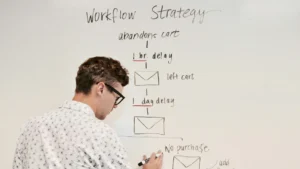Like most of us, you probably use various Word documents and Excel spreadsheets to stay on top of your day-to-day.
Are these solving the problem perfectly? The answer is often “not really”.
That’s why, as we shared in our last article, so many organisations are adopting digital tools to solve their problems.
But what if the products you need doesn’t actually exist yet?
This was the position we found ourselves in a few years ago. As a design and development studio we have to provide regular estimates for our clients’ projects. For a long time we used spreadsheets to do this.
But spreadsheets can only do so much and soon we were attempting to add in features that didn’t fit.
Since no existing tool met our needs, we built one ourselves. We took what worked from our spreadsheets and transformed it into a digital product; and soon, Plexi, was born.
Our clients loved it. We saved time, improved our workflow and found we could collaborate with them more easily. On top of that we’d built something that we could turn into a commercial proposition.
It was another reminder for us that the problems or frustrations you and your users come up against are usually the best source of product ideas and innovation.
Especially if you want to start turning your services and offerings into digital products.
If you’re looking to turn your services into digital products, here’s how to approach product planning and process in three easy steps.

Step 1: Distill your digital service idea
“While it’s important to plan for success and mitigate against failure, what’s equally worthwhile exploring is why the idea matters to you and the people you hope it will serve. Why should you give it priority?”
The starting point to turning any of your services into digital offerings isn’t what tech you need but how to interrogate your ideas properly (And if you don’t have any product ideas at all, learn how you can generate them quickly and easily)
At this stage in the process, all you’ll need is a plain piece of paper, but you could also use something like Ash Maurya’s Lean Canvas.
Start sketching out your idea for you initiative, using these questions as a starting point:
- What problem are we hoping to solve with our initiative?
- What is the value of solving it for our customer? What is the value for our business?
- Why this project and not something else?
- What assumptions are we making here?
- How difficult is this problem to solve?
Once you have your answers down, leave them for a while before reviewing
Once you have a top level vision or pitch for your project you’d be proud to sign your name to, you’re ready to proceed to step 2.
Step 2: Validate your idea with potential users
It’s amazing how many organisations skip this part. Whether it’s an internal project or an innovation aimed at customers, you’ll need to speak to the person whose problem you’re hoping to solve. Validating your idea with research is something anyone can do. It can also be great fun and a fascinating part of the process.
Research sessions can take many forms but we prefer to keep them lightweight. Just a handful of fifteen minute conversations with a small set of people will teach you plenty.
Here’s how to approach it:
- Find the right people (avoid asking colleagues or friends who may be biased).
- Ask open-ended questions (don’t lead them or influence their answers).
- Listen more than you talk.
If people truly have the problem you’re researching, then they will have tried to solve it, so ask them about that experience.
Even if you have an idea, don’t introduce it at this stage. You want a true picture of a person’s world. If you introduce new things, the picture will inevitably change.

Step 3: Make something real
Once you have stress tested your idea and validated the problem with the right people, it’s time to get meaningful feedback.
You’ll need a way to demonstrate a product with something tangible that people can see and interact with.
Sometimes you may want to make this look like a well-designed, fully functioning product but for simplicity’s sake a quick and dirty prototype with little or no coding will do just fine.
A typical prototype is usually a handful of screens of your solution mocked up and made into a clickable tool.
Some effective low-fidelity prototypes include:
- Clickable wireframes with just enough detail to communicate the core functionality.
- A simple landing page that describes the product and invites sign-ups.
- A lightweight MVP (Minimum Viable Product) with only the essential features.
The purpose of this is to create something you can offer up as a quick guided tour. Your user will be none the wiser and will assume that this is the real deal which enables them to give meaningful feedback.
Run your feedback sessions the same way as your research sessions; avoiding bias and listening, rather than talking.
What’s next? To build or not to build
Now you have meaningful feedback, you can take what you’ve learnt from your product planning and process. Push that learning back into your vision.
Has it changed what you should be offering and to whom? Do you know enough to press the button on designing and building the final tool? If not, what assumptions need testing next?
If you’ve completed these steps and didn’t learn something that changes how you think about your idea, then you probably didn’t do them properly.
Repeating this process over and over, consolidating your learnings every time, shows you what will create real change in your organisation.
More importantly, the product leadership skills you develop in this process will drive future innovation.

The power of iterative product development
Innovation isn’t about getting everything right the first time. The best products come from repeated cycles of learning, testing, and refining.
The product planning and process skills you develop along the way will set the foundation for future innovations. Whether you’re tackling inefficiencies in your own workflow or identifying a gap in the market, the key is to start small, test relentlessly, and let real-world feedback guide your decisions.
If you’ve validated an idea and are ready to move forward, we’d love to hear about it. Let’s talk about how to bring it to life.